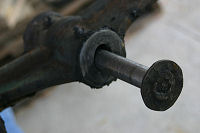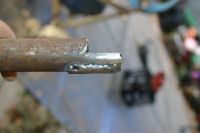The mixer I’m using is a hand-me-down from my Dad, and it’s life before that would not have been easy being a communal mixer used by immigrants arriving in Australia after WWII. Back then the “new” Australians got none of the luxuries todays immigrants get so they either got on with building a home themselves with the help of like minded members of the community or they kept living in I would imagine squalid conditions in tents and nissen huts. Doing some research on it a few years back now I worked out this mixer was made in Adelaide in the 1940’s and 1950’s so it has some age behind it.
The poor old thing is getting tired and has literally worn out the yoke that holds the bowl causing the gears to miss and drive to the bowl to stop. I’ve spent the last couple of days thinking about how to fix the issue without a literal rebuild in a machine shop, and here is what I came up with as a fix.




Pic 1 is removing the bowl with the assistance of a verandah beam and a pair of ratchet straps. Pic 2 shows the wear from the back of the yoke. Pic 3 shows almost identical wear at the front of the yoke where the bowl sits. Pic 4 is where I’ve marked the sleeve I need to manufacture and fit start and finishes.




In Pic 1 and 2 above I’ve used a bit of pipe with an inner diameter roughly the same as the pin. I’ve used the pen marks from the pic set above to cut a radius of the pipe. To the back of the radius I welded some 3mm strap steel and then used the grinder to shape it so it fit snugly around the pin as in Pic 3. The yoke is cast iron and is a pig (no pun intended) of a thing to weld anything to, so many repetitive rounds of weld and grind end up with the result in Pic 4. The sleeve itself is not full width of the yoke, as the wear pattern is much like 2 cones stacked point to point and therefore impossible to fit in one piece. Instead I have made a 40mm section fitted to each end.
I repeated the procedure with the front side of the yoke, also adding a layer of weld rod steel to the face of the yoke to harden it and hopefully help keep things aligned to avoid this sort of wear again. I’m not sure how long this fix will last, but I’m sure hoping it at least sees out the build. I have greased and run the mixer unloaded and the “tipping point” noticable in the bowl before the fix is gone.















